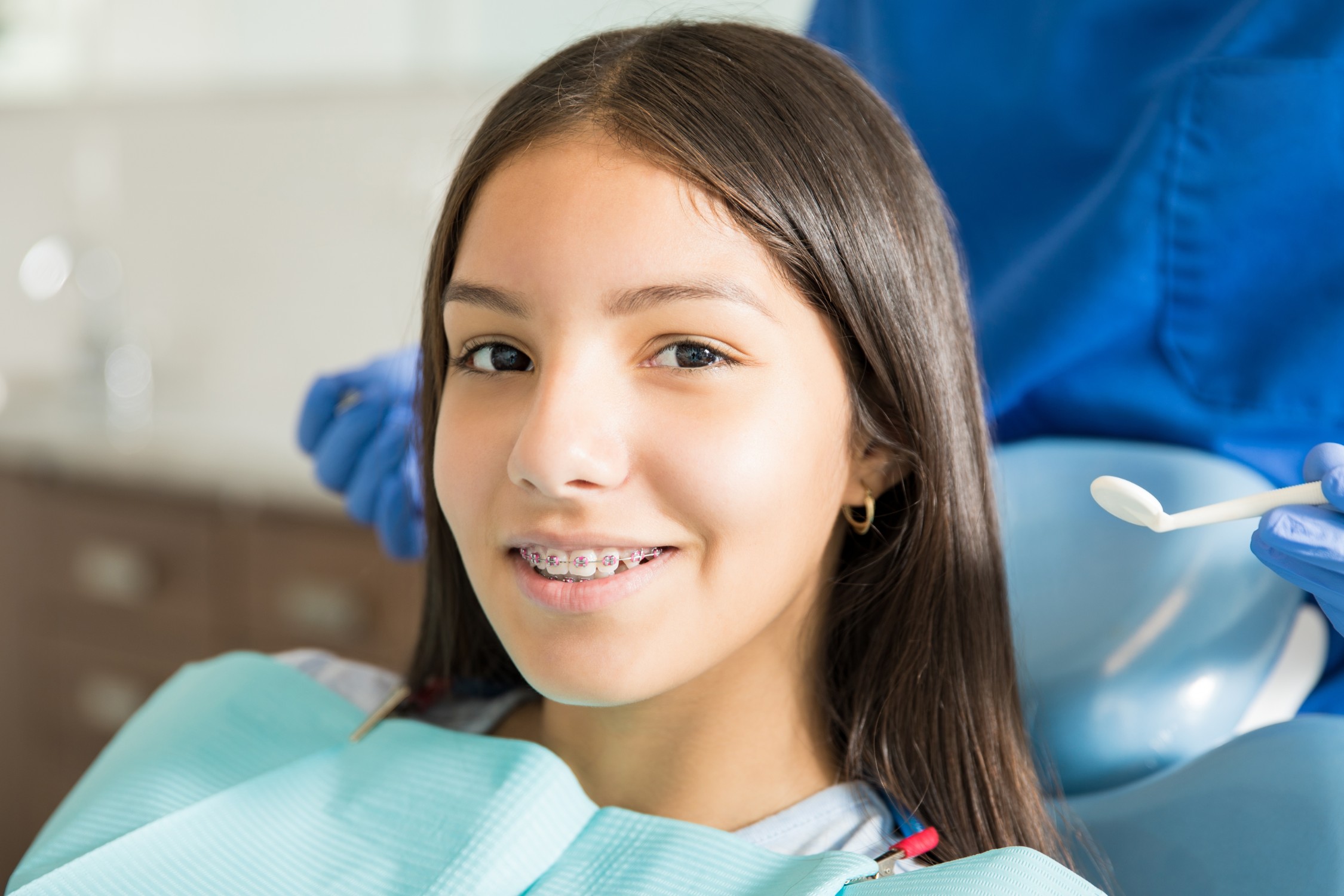Did you know that traditional braces are one of the most efficient tools orthodontists have for straightening smiles? They’re also one of the most popular and easily recognizable treatments we offer. Braces have been around for a long time, and have a proven track record of successfully correcting mild and complex orthodontic issues. Even though they tend to be top orthodontic treatment year after year, there’s a lot about braces that new patients don’t know. To help you understand more about braces, the treatment process, and how it all works together to give you a healthy smile, we’ve put together this Braces FAQ. Keep reading to find out more!
What are braces made of?
Braces have a number of components that work in conjunction with each other to move the teeth. This includes:
Brackets
Brackets are usually made from a mix of stainless steel, nickel, ceramic, or other high-quality materials. Each bracket has a little hook or door over which a wire is threaded, and it can be secured by closing the door or applying an elastic over the top of the wire.
Glue
Some orthodontists still attach the brackets to a metal band, but these days, it’s much more common to attach the bracket directly to the tooth with glue. The glue used to attach brackets is technically a form of composite bonding material. In more complex cases that require more intensive treatment, metal bands may be used together with glue in order to give the braces a bit more leverage and stability.
Wire
Wires are the thin pieces of metal that run from one bracket to another. Dr. Faja-Fernandez will adjust the shape and curvature of the wire regularly in order to move your teeth in the desired directions. He may also put crimps in the wire to help push or pull any teeth that are being especially stubborn. Sometimes the wire will attach all of the bottom or upper teeth together, but occasionally we will cut the wire strategically if connecting just a few teeth is better for the overall treatment plan.
Elastics
Elastics are essential for patients who need bite correction. They’re generally strung between an upper bracket hook and a lower bracket hook, and pull the upper jaw backwards to correct an overbite, or the lower jaw backwards to correct an underbite. Rubber bands are also used in a number of different scenarios, especially if we want to exert extra pressure on the teeth or jaws.
Orthodontic bands
These stainless steel rings are cemented to the teeth using dental bonding agents, and can provide an anchor for braces and other orthodontic appliances. However, we don’t use them with every patient.
Spacers
These small elastic “donuts” or rings are used to create space in between the teeth when needed, usually, before the bands are placed. You may also hear them called separators.
Elastic ties/o-rings/ligatures
These tiny rubber rings or bands attach the arch wire to the brackets. They tend to be less rigid than spacers and are often offered in a wide variety of fun colors!
How do braces work?
The first step in any orthodontic process is an initial consultation. Seabreeze Orthodontics is proud to offer free consultations to patients of all ages in Myrtle Beach and the surrounding communities. Your first visit with us will give you the opportunity to meet our team, learn more about orthodontics, and receive a complete initial exam. You’ll also talk with our team about which treatment options are best suited to your needs.
During your initial consultation, we will:
- review your dental and medical history forms
- provide a complete oral exam, including X-rays, to determine whether treatment is necessary
- create a customized treatment plan for you
- discuss all financial information, insurance options, and payment plans
During this time, Dr. Faja-Fernandez will be happy to answer any questions you may have, and our team provides all of the information you need to decide which treatment is right for you. Once the appointment is complete, we’ll schedule you to come back in and have your braces put on.
After the brackets have been attached to your teeth, the wire will be inserted. By bending the wire in a particular way, we’re able to encourage specific and precise movements, as these provide different types of pressure on different teeth. This can help a tooth that is twisted to turn and face the right way, for example, or align a tooth that is too far forward with one that is too far back. This entire process is what we refer to as remodeling, and involves minor changes in the bone surrounding the roots of teeth.
During the remodeling process, pressure is put on the tooth. As a result of this pressure, cells called osteoblasts and osteoclasts form around the tooth’s root. Together with the pressure of the wire, the osteoblasts and osteoclasts create negative pressure on one side of the tooth. At this site, bone is removed. On the other side of the tooth, the bone is reformed. As bone is absorbed on one side and then deposited on the other side, the tooth will slowly begin to move into the correct position.
This process is only able to occur if constant pressure is put on the tooth. Once the pressure stops – like when your braces are removed – the tooth will begin to settle into its new position. However, most teeth will begin drifting back to their old positions over time without the presence of steady pressure. This is exactly why retainers are so important! Regular retainer use after your braces come off is the best way to help keep teeth in their new, improved positions and prevent any natural drifting.
What is the best way to care for braces?
When it comes to dental hygiene, traditional braces can come with a bit of a learning curve, especially in the early days. Hang in there! With a little patience and a lot of practice, you’ll get the hang of it in no time. Keeping your teeth and gums clean and free of debris is especially important during orthodontic treatment. Food particles can stick in the nooks and crannies of braces, giving bad bacteria a place to grow, but brushing and flossing with brackets, wires, and bands can sometimes be a little tricky.
Thankfully, there are lots of accessories available that have been designed to make oral hygiene easier for braces patients. Oral irrigators are a great tool that use a pressurized stream of water to help thoroughly rinse those hard to reach places, and ortho-picks are really helpful when it comes to braces-specific flossing.
Caring for your braces doesn’t stop with brushing and flossing. There are also a number of food restrictions that come with traditional braces. In order to protect your braces and your teeth, anything crunchy or chewy will need to go on the back burner until your treatment is complete. This includes things like certain types of raw fruits and veggies, popcorn, gum, nuts, and many kinds of candy and chips. This definitely takes some getting used to, but remember – this part is only temporary! All your hard work will be more than worth it once your braces come off and you see your beautiful new smile.
How often are follow-up appointments?
Dr. Faja-Fernandez will make adjustments to your braces at regular intervals throughout the course of your treatment. This allows him to keep up with the movements your teeth are making, as well as track your progress and make sure everything is going according to plan. These will normally be scheduled for every 4-8 weeks or so, and the bands that are attached to your brackets may be changed at this time. The wire may be replaced as well.
Following an adjustment appointment, you may experience some slight soreness, but it should only be temporary. It’s important you don’t miss out on these visits! They’re a crucial part of your overall treatment plan, and help us ensure that you get the very best results in the least amount of time. We do our best to keep these visits short, so you can get back to work, home, or school as quickly as possible.
How long will braces treatment last?
The million dollar questions – and the one we don’t really have an answer for! That’s because every case is different, each smile is unique, and every patient responds to treatment in their own way. Although there’s no “one size fits all” answer to how long you’ll need to be in braces, the average treatment time is usually around 12-24 months. Fortunately, you’ll often see signs of improvement relatively quickly with traditional braces. This can give you confidence in the treatment process, and a boost of encouragement on your way to a straighter smile!
Take your first step towards a straighter smile with Seabreeze Orthodontics
Here at Seabreeze Orthodontics, we love creating beautiful smiles! Our talented team is committed to providing every patient we see with the highest quality orthodontic care, and that starts with an individualized and compassionate approach. We want you to feel like family from the moment you walk through our door, and proudly serve patients of all ages from Myrtle Beach and beyond. If you’d like more information on how braces can benefit your smile, get in touch with us today to schedule a FREE consultation. A healthier, straighter smile is waiting for you!


